Abstract
We investigated the combined moisturizing effect of liposomal serine and a cosmeceutical base selected in this study. Serine is a major amino acid consisting of natural moisturizing factors and keratin, and the hydroxyl group of serine can actively interact with water molecules. Therefore, we hypothesized that serine efficiently delivered to the stratum corneum (SC) of the skin would enhance the moisturizing capability of the skin. We prepared four different cosmeceutical bases (hydrogel, oil-in-water (O/W) essence, O/W cream, and water-in-oil (W/O) cream); their moisturizing abilities were then assessed using a Corneometer®. The hydrogel was selected as the optimum base for skin moisturization based on the area under the moisture content change-time curves (AUMCC) values used as a parameter for the water hold capacity of the skin. Liposomal serine prepared by a reverse-phase evaporation method was then incorporated in the hydrogel. The liposomal serine-incorporated hydrogel (serine level=1%) showed an approximately 1.62~1.77 times greater moisturizing effect on the skin than those of hydrogel, hydrogel with serine (1%), and hydrogel with blank liposome. However, the AUMCC values were not dependent on the level of serine in liposomal serine-loaded hydrogels. Together, the delivery of serine to the SC of the skin is a promising strategy for moisturizing the skin. This study is expected to be an important step in developing highly effective moisturizing cosmeceutical products.
The human skin consists of three distinct layers: the epidermis, dermis, and subcutaneous layers. Among these, the epidermis is composed of stratum germinativum and stratum corneum (SC) and forms a protective barrier against the loss of moisture and electrolytes from the body and thus maintains normal skin physiology [1]. In the SC, the corneocytes produced from a proliferating keratinocyte are surrounded by the lamellar bodies of lipids, including ceramides, cholesterol, and fatty acids. Natural moisturizing factor (NMF), which is exclusively observed in the corneocytes of the SC, is a group of naturally occurring hydrophilic components including free amino acids, pyrrolidone carboxylic acid, lactate, sugars, urea and minerals [2]. Hygroscopic NMF components are able to bind water molecules from the atmosphere and combine it with their own water content, thus allowing the stratum corneum to stay hydrated.
Damage to the skin from causes such as atopic dermatitis, especially to the SC, lead to decreased levels of amino acids among the various NMF components in the SC [3]. Further and continuous impairment by routine soap cleansing, frequent exposure to ultraviolet light and aging worsens skin damage [45]. Of a variety of amino acids acting as NMF, serine is known to be the most abundant component, estimated at approximately 23% of all amino acids [36]. Serine is considered to contribute largely to the moisturization of the skin, as hydroxyl groups of serine can actively interact with water molecules [3]. We therefore hypothesized that serine efficiently delivered to the SC of the skin would enhance the moisturizing capability of the skin as demonstrated by the NMF. However, the hydrophilic and low membrane permeable properties of serine were expected to limit its efficacious delivery to the SC and its ability to become available as NMF in the SC. Liposomes providing hydrophilic and lipophilic domains for drug loading have frequently shown the ability to improve the membrane permeability of numerous drugs with different polarities by disturbing the lipid packing of biological membranes including the SC [78]. It would thus be advantageous to use liposomes as carriers for the delivery of serine to the SC of the skin.
In the present study, we aimed to design cosmeceutical formulations with liposomal serine for enhanced delivery of serine to the SC to improve skin moisturization. As cosmeceutical bases play a key role in skin moisturization, four different cosmeceutical bases (hydrogel, oil-in-water (O/W) essence, O/W cream, and water-in-oil (W/O) cream) were prepared, and the moisturizing ability was assessed to select an optimum cosmeceutical base. Thereafter, liposomal serine was eventually incorporated in the selected cosmeceutical base, and the combined skin moisturizing effect of liposomal serine and the base were investigated.
L-serine was purchased from Sigma-Aldrich Company (St. Louis, MO, USA). Egg phosphatidylcholine was obtained from Lipoid GmbH (Ludwigshafen, Germany). Carbopol ETD 2020 (Acrylates/C10-30 Alkyl Acrylate Crosspolymer, International Nomenclature of Cosmetic Ingredients, INCI name) was provided by The Lubrizol Corporation (Wickliffe, OH, USA) and Rhesperse RM100 (Sodium Polyacrylate, INCI name) was supplied from Sensient Cosmetic Technologies (South Plainfield, NJ, USA). All other chemicals were reagents grade and obtained from Sun Fine Global Co., Ltd. (Cheongju-si, Chungbuk, Korea), Ewoo Chemicals (Seoul, Korea), or the KCC Corporation (Seoul, Korea).
Phosphatidylcholine (500 mg) was accurately weighed and placed in a round-bottom flask. Absolute ethanol (5 ml) was added to the phosphatidylcholine and dissolved it completely by gentle shaking. The ethanol was then evaporated under vacuum at room temperature (approximately 20℃) to form a thin film of phosphatidylcholine. Ethyl ether (15 ml) was then added, and the mixture was stirred on a magnetic stirrer for 5 min and used as an organic phase. Separately, serine (200 mg) was dissolved in water (5 ml) and this was used as an aqueous phase. The aqueous phase was carefully added to the organic phase for emulsification, and the emulsion was sonicated in a bath-type sonicator at room temperature. The organic solvent was removed by a rotary vacuum evaporator at 37℃. The serine-loaded liposomal dispersion was extruded five times through a nylon membrane filter with a pore size of 0.45 µm.
The physical characteristics of liposomal serine such as particle size and zeta potential values were evaluated using a dynamic light scattering method with Zetasizer Nano-ZS (Malvern Instrument, Worcestershire, UK). The stability of the particle sizes of liposomal serine was also examined for 24 h at 37℃.
Four different cosmeceutical bases used as liposomal serine carriers and moisturizers were formulated; components and percent compositions of the final formulations tested in the current study are shown in Table 1. In order to compare the effect of cosmeceutical base type on skin moisturization, hydrogel, O/W essence, O/W cream and W/O cream bases were employed. The ingredients listed from Carbopol ETD 2020 to water were in the aqueous phase, while the ingredients listed from Tween 80 to olive oil were in the oil phase. The hydrogels were prepared by dissolving Carbopol ETD 2020 and Rhesperse RM100 in distilled water and to this the rest of the ingredients were added and dissolved. The O/W essence, O/W cream and W/O cream were produced by emulsifying the oil phase with the aqueous phase at 75℃ followed by cooling to room temperature.
When preparing liposomal serine-loaded hydrogel bases, a portion of the water added to the hydrogels was replaced with liposomal serine dispersions. Levels of serine in the hydrogels were controlled by changing the amount of liposomal serine.
The skin moisturizing abilities of various moisturizing bases were evaluated using a Corneometer® (Courage+Khazaka Electronic GmbH, Germany) after applying them to the skin of the anterior forearms. The measurements were performed in a room in which the temperature and relative humidity were maintained at 21±3℃ and 40±5%, respectively. The subjects were acclimated in the room for at least 30 min. Prior to the measurements, the anterior forearm 5 cm away from the wrist was labeled with adhesive tape to indicate the area (3×3 cm) where the cosmeceuticals were applied. Each formulation (0.5 g) was applied with an index finger covered in a latex glove, and the formulation was continuously scrubbed until no sign of the formulation remained. The corneometer probe was then attached to the skin surface, and skin moisture content in arbitrary units was recorded. The data reading was carried out within 10 min to avoid skin occlusion. The measurements were made as a function of time up to 3 hours. Time-dependent changes in skin moisture were then evaluated by calculating the area under the profiles showing changes in skin moistures, with time used to judge the efficiency of skin moisturization [9]. The age of participants ranged from 24~26, and written informed consent was obtained following a thorough explanation of the study with its purpose and risks. The procedure complied with tenets of the Declaration of Helsinki (version 2000; World Medical Association).
Data are presented as mean±SD and were recorded from five independent measurements on each subject. Student's t-test was carried out using the Microsoft Excel 2010 program (Microsoft Corporation, WA, USA), and for statistical comparison, p values less than 0.05 were considered statistically significant.
The particle sizes of liposomal serine ranged between 200~250 nm with a polydispersity index of less than 0.3, indicating that liposomal serine is a nano-sized carrier for serine and the particle size distribution of liposomal serine was considered to be narrow. The particle sizes of liposomal serine were not considerably changed for 24 h when stored at 37℃. This was probably due to the low zeta potential values of -25 mV.
The moisture contents of the skin were measured before and after the application of hydrogel, O/W essence, O/W cream and W/O cream. The observed values of skin moisture were plotted against time (Fig. 1A). Right after the application of the test formulations (i.e., at t=0), skin moisture contents increased considerably and subsequently decreased when measured at 0.5 h. The values were not greatly changed again until the last measurement at 3 h. As the skin moisture content measured in arbitrary units as a function of time did not allow for quantitative comparison of the effect of cosmetic vehicles on skin moisturization, the profiles of the changes in moisture contents of the skin were produced with time (Fig. 1B). The area under the moisture content change-time curves (AUMCC) was used as a parameter for water holding capacity of the skin. The AUMCC value of the hydrogel was 1.03 (O/W essence) -1.56 (W/O cream) times greater. In addition, when the water content within the SC was measured 3 h after the application, the hydrogels increased the water content by 42.40% when compared to the initial value (arbitrary unit) measured before the application of test formulations.
The above study allowed the selection of a hydrogel base as a carrier for liposomal serine. The serine-encapsulated liposomes are free flowing aqueous dispersions; to be more effective bases, liposomal serine may be required. Fig. 2 illustrates the effect of hydrogels loaded with serine, blank liposomes, and liposomal serine on the moisture content of the skin. Based on changes in skin moisture content, the AUMCC values were computed and are shown in Table 2. The AUMCC values of hydrogel with liposomal serine (serine level=1%) were estimated to be 203.21±51.16 and were found to be approximately 1.62~1.77 times greater than those of hydrogel, hydrogel with serine (1%), and hydrogel with blank liposome (i.e., liposomes without serine).
Fig. 3 displays the effect of serine levels in the liposomes incorporated in hydrogel bases on the moisture content of the skin. Unexpectedly, the AUMCC values were not dependent on the level of serine in liposomal serine-loaded hydrogels. Indeed, the maximum AUMCC values were observed with hydrogel with liposomal serine (serine level= 1%), and increased serine levels (i.e., 1.5%) caused a decrease in AUMCC values (Table 2).
Since skin capacitance is affected by the water content of the stratum corneum, a corneometer that monitors capacitance as an indicator of the amount of water in the skin surface was used to monitor moisture changes in the skin [10]. Our current study aimed to assess serine as a moisturizing component in cosmeceuticals, as serine has been reported to be the major amino acid in NMF and keratin; in addition, the hydroxyl group of serine can actively interact with water molecules [3]. However, the hydrophilic property of serine needs to be modified to allow efficient delivery of serine to the SC. Therefore, a liposome was selected to encapsulate serine with a lipid bilayer formed from phosphatidylcholine, as it has been proven that liposomes improve the delivery of hydrophilic drugs across biological membranes. Liposomal drugs are commonly incorporated into cosmeceutical bases when developing cosmetic products [11]. Thus, a suitable cosmetic base was selected by comparing skin moisturization abilities of hydrogel, O/W essence, O/W cream and W/O cream. These four bases were compared due to uncertainty regarding which was the most appropriate base for serine and for use as a skin moisturizer.
Fig. 1B shows that hydrogel and O/W essence formulations were almost equal in increasing skin moisture contents; however, when comparing AUMCC values, the hydrogel was slightly better than O/W essence, although the difference was not statistically significant. The reason for this might be the fact that hydrogels can provide immediate hydration effects into the skin due to the instant contact of the water molecules with the skin [12]. Hydrogels were prepared primarily with Carbopol ETD 2020, Rhesperse RM100 and hyaluronic acid, as listed in INCI. Moreover, our experience and literature search supported the above-mentioned gelling agents, as they have been known to be less irritating and toxic, allowing their use in ocular products [13]. From this study, we selected the hydrogel as the best moisturizing base and vehicle for liposomal serine.
Fig. 2 and Table 2 clearly demonstrate that the liposomal serine incorporated in the hydrogel in the above study was effective at increasing the moisture content of the skin. The results obtained in this study may support the hypothesis that serine efficiently delivered to the skin enhances the moisture content of the skin. Natural moisturizing factors, including serine, are highly efficient humectants that are able to hold water molecules from the atmosphere and bring them into the SC [14]. We thus hypothesized that liposomal delivery of serine, the richest component among the hydrophilic amino acids of NMF, could improve the introduction of serine into the SC where NMF is found; as a result, the moisturizing ability of the skin would increase. Furthermore, as the hydrogel employed in this study was useful at moisturizing the skin, the combined effect of liposomal serine and moisturizing bases may be another reason for the effective moisturizing caused by hydrogel incorporated with serine (1%).
Although serine delivered by liposomal hydrogels was effective at increasing the moisture content of the skin, it was unexpectedly observed that the moisturizing effect was not dependent on the level of serine in liposomal hydrogel. This may be a result of the interference of liposome particles on the hydration effect of hydrogel bases [15]. In practice, in order to increase the level of serine in liposomal hydrogels, an increased amount of liposomal dispersion of serine is needed. To overcome this hurdle, we established a strategy in which the levels of serine in hydrogel can be controlled without increasing the amount of liposomes in further studies. When screening cosmeceutical bases, W/O cream exhibited the lowest moisturizing effect compared to hydrogel and O/W type bases (i.e., O/W essence and O/W cream). These results suggest that under the experimental conditions employed, the moisturizing effect of the cosmetic formulations was better exerted. However, we have not assessed long-term effects of the different bases prepared in this study with or without liposomal serine. We plan to investigate the long-term moisturizing effects of our cosmeceutical formulations in the near future.
In conclusion, the increased moisturizing ability of liposomal serine loaded hydrogels was successfully evaluated in a non-concentration dependent manner. Further research should be completed to optimize the levels of liposomal carriers in hydrogel bases with long-term observation. This study is expected to be an important step in developing highly effective moisturizing cosmeceutical products.
ACKNOWLEDGEMENTS
This study was supported by a grant of the Korean Health Technology R&D Project, Ministry of Health & Welfare, Republic of Korea (Grant No. HN13C0073).
References
1. Washington N, Washington C, Wilson CG. Transdermal drug delivery. In : Washington N, Washington C, Wilson CG, editors. Physiological pharmaceutics: Barriers to drug absorption. 2nd ed. London: Taylor and Francis;2001. p. 181–198.
2. Rawlings AV, Harding CR. Moisturization and skin barrier function. Dermatol Ther. 2004; 17(Suppl 1):43–48. PMID: 14728698.

3. Nakagawa N, Naito S, Yakumaru M, Sakai S. Hydrating effect of potassium lactate is caused by increasing the interaction between water molecules and the serine residue of the stratum corneum protein. Exp Dermatol. 2011; 20:826–831. PMID: 21771099.

4. Lee H, Ha H, Lee JK, Park SJ, Jeong SI, Shin HK. The leaves of Broussonetia kazinoki siebold inhibit atopic dermatitis-like response on mite allergen-treated Nc/Nga mice. Biomol Ther (Seoul). 2014; 22:438–444. PMID: 25414775.

5. Verdier-Sévrain S, Bonté F. Skin hydration: a review on its molecular mechanisms. J Cosmet Dermatol. 2007; 6:75–82. PMID: 17524122.

6. Zhou XM, Idler WW, Steven AC, Roop DR, Steinert PM. The complete sequence of the human intermediate filament chain keratin 10 Subdomainal divisions and model for folding of end domain sequences. J Biol Chem. 1988; 263:15584–15589. PMID: 2459124.

7. Nguyen XK, Lee J, Shin EJ, Dang DK, Jeong JH, Nguyen TT, Nam Y, Cho HJ, Lee JC, Park DH, Jang CG, Hong JS, Nabeshima T, Kim HC. Liposomal melatonin rescues methamphetamine-elicited mitochondrial burdens, pro-apoptosis, and dopaminergic degeneration through the inhibition PKCδ gene. J Pineal Res. 2015; 58:86–106. PMID: 25407782.

8. Kim H, Kim Y, Lee J. Liposomal formulations for enhanced lymphatic delivery. Asian J Pharm Sci. 2013; 8:96–103.
9. Piérard-Franchimont C, Letawe C, Goffin V, Piérard GE. Skin water-holding capacity and transdermal estrogen therapy for menopause: a pilot study. Maturitas. 1995; 22:151–154. PMID: 8538484.

10. Matsumoto T, Yuasa H, Kai R, Ueda H, Ogura S, Honda Y. Skin capacitance in normal and atopic infants, and effects of moisturizers on atopic skin. J Dermatol. 2007; 34:447–450. PMID: 17584321.

11. Betz G, Aeppli A, Menshutina N, Leuenberger H. In vivo comparison of various liposome formulations for cosmetic application. Int J Pharm. 2005; 296:44–54. PMID: 15885454.

12. Leite e Silva VR, Schulman MA, Ferelli C, Gimenis JM, Ruas GW, Baby AR, Velasco MV, Taqueda ME, Kaneko TM. Hydrating effects of moisturizer active compounds incorporated into hydrogels: in vivo assessment and comparison between devices. J Cosmet Dermatol. 2009; 8:32–39. PMID: 19250164.
13. Debbasch C, De La Salle SB, Brignole F, Rat P, Warnet JM, Baudouin C. Cytoprotective effects of hyaluronic acid and Carbomer 934P in ocular surface epithelial cells. Invest Ophthalmol Vis Sci. 2002; 43:3409–3415. PMID: 12407150.
14. Chandar P, Nole G, Johnson AW. Understanding natural moisturizing mechanisms: implications for moisturizer technology. Cutis. 2009; 84(1 Suppl):2–15. PMID: 19702109.
Fig. 1
Effect of formulation type on moisture content of the skin (A). Changes in moisture content of the skin as a function of time (B) are plotted to assess the moisture hold capacity of the skin by calculating the area under the moisture content change-time curve. Mean±SD (n=40~50).
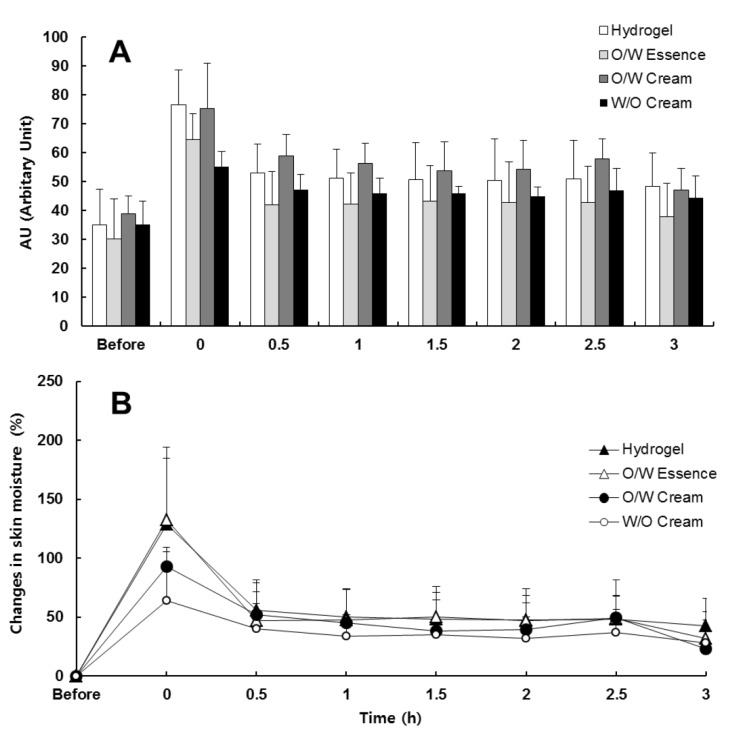
Fig. 2
Effect of serine, blank liposomes, and hydrogel loaded with liposomal serine on the moisture content of the skin. The profiles of changes in the skin moisture contents were produced after monitoring the moisture content values of the skin measured at 0, 0.5, 1, 1.5, 2, 2.5 and 3 h of the experiments. Mean±SD (n=40~50).
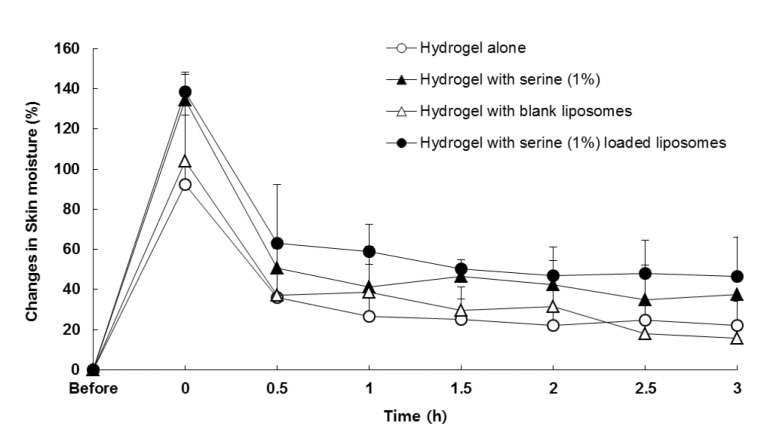
Fig. 3
Effect of serine levels in the liposomes incorporated in hydrogel bases on moisture content of the skin. The profiles of changes in skin moisture contents were produced after monitoring the moisture content values of the skin measured at 0, 0.5, 1, 1.5, 2, 2.5 and 3 h of the experiments. Mean±SD (n=40~50).
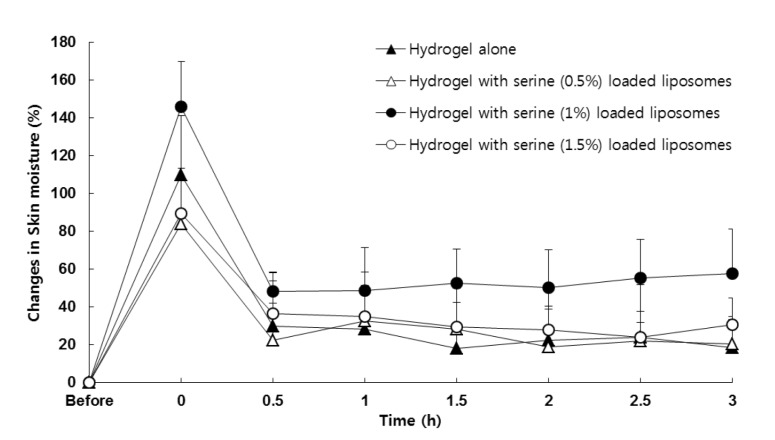
Table 1
Whole ingredients and percent compositions of hydrogel, oil-in-water (O/W) essence, O/W cream and water-in-oil (W/O) cream bases
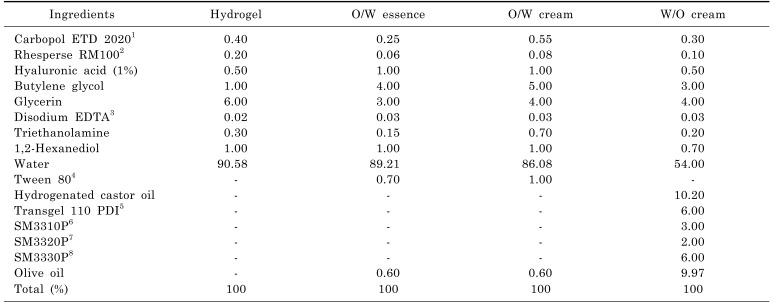
1Acrylates/C10-30 alkyl acrylate crosspolymer, 2Sodium polyacrylate, 3Disodium ethylenediaminetetraacetic acid, 4Polyoxyethylene (20) sorbitan monooleate, 5Hydrogenated polydecene, caprylic/capric triglyceride, hydrogenated styrene/isoprene copolymer, 6Polyethylene glycol-11 methyl ether dimethicone, 7Polyethylene glycol-10 dimethicone, 8Cetyl polyethylene glycol/polypropylene glycol-10/1 dimethicone.




 PDF
PDF ePub
ePub Citation
Citation Print
Print


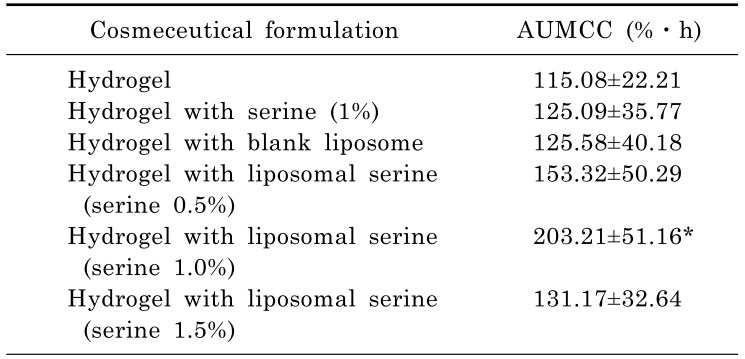
 XML Download
XML Download